Case Study: License to Thrill – Marvel’s Global Licensing Success

Marvel Enterprises has transformed from a comics company into a global character-based entertainment licensing powerhouse over its 70-year history. With a library of over 5,000 characters created by figures like Stan Lee, Marvel has successfully brought many popular characters to film (Iron Man, Spider-Man, X-Men, Hulk) primarily to increase character recognition rather than generate direct film revenue.
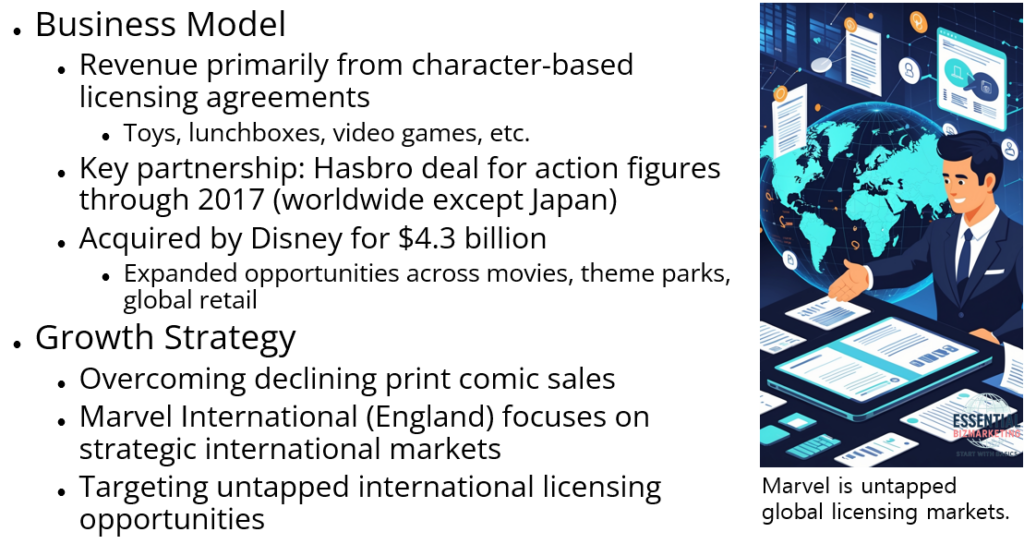
The company’s earnings are largely driven by character-based licensing agreements for products like toys, lunchboxes, and video games. Key business relationships include a long-term deal with Hasbro for action figure distribution worldwide (excluding Japan) through 2017, and Marvel’s acquisition by Disney for $4.3 billion, which has expanded opportunities for character exploitation across movies, theme parks, and global retail.
Despite declining print comic sales, Marvel continues to grow, particularly through Marvel International (based in England), which focuses on developing licensing business in strategic international markets that the company views as largely untapped.
1. Introduction to Entry Modes

When companies expand into international markets, they must decide how to enter. This decision depends on factors such as costs, risks, and control over operations. The main entry modes include exporting, importing, and countertrade, contractual entry modes, and investment entry modes.
2. Exporting, Importing, and Countertrade

Companies export goods primarily to increase sales beyond the domestic market, diversify income sources to reduce financial risks, and gain international business experience. To successfully export, companies should follow a structured process. First, they must identify a potential market by researching demand and regulations. Next, they should match their abilities to market needs to ensure they can meet demand. The third step involves initiating meetings to build relationships with buyers and distributors. Finally, they must commit resources by allocating time, money, and staff to support the export process.
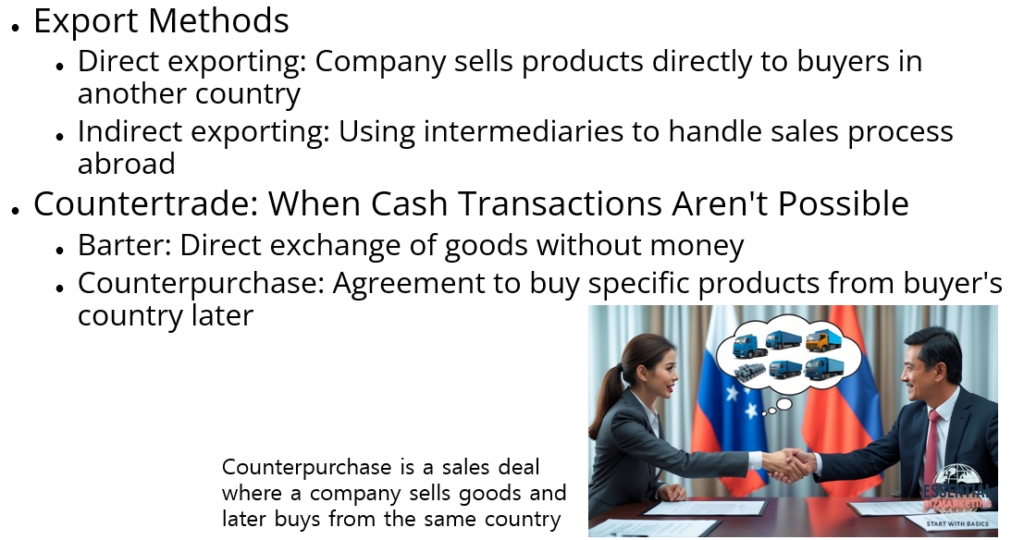
Exporting can be conducted in two ways. Direct exporting occurs when a company sells its products directly to buyers in another country. Indirect exporting involves using intermediaries to handle the sales process abroad. In some cases, when cash transactions are not possible, companies engage in countertrade, which involves exchanging goods or services instead of money.
There are several forms of countertrade. Barter is the direct exchange of goods without the use of money. Counterpurchase refers to an agreement where a company sells goods and, in return, agrees to buy specific products from the buyer’s country at a later date. Offset is a similar arrangement, but it does not specify the type of product that must be purchased. Switch trading occurs when a company sells its obligation to buy goods to another company. Buyback happens when a company supplies equipment and is paid with the goods produced by that equipment.
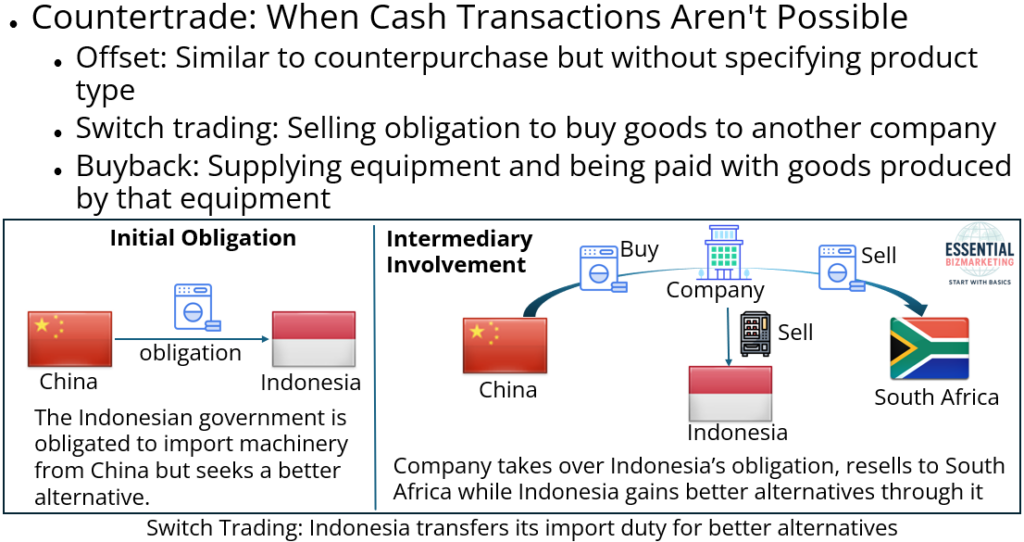
The image above explains switch trading. The Indonesian government originally has an obligation to import machinery from China. However, Indonesia does not necessarily need this machinery or is looking for a better alternative.
A company steps in as an intermediary. This European company (B) offers to purchase the machinery that Indonesia was supposed to import from China. In other words, the company takes over Indonesia’s purchasing obligation. The company buys the machinery from China and then either resells it to an South Africa or utilizes it in its own factory.
As a result, the Indonesian government does not receive the machinery directly from China. Instead, through the company, Indonesia may obtain more useful alternative goods, such as European medical equipment.
3. Export and Import Financing Methods

International trade involves risks for both sellers and buyers, and various financing methods help manage these risks. Advance payment requires the importer to pay before the shipment is made, which benefits exporters by eliminating non-payment risks. Documentary collection involves a bank acting as an intermediary to process the payment, though it does not assume financial risk.
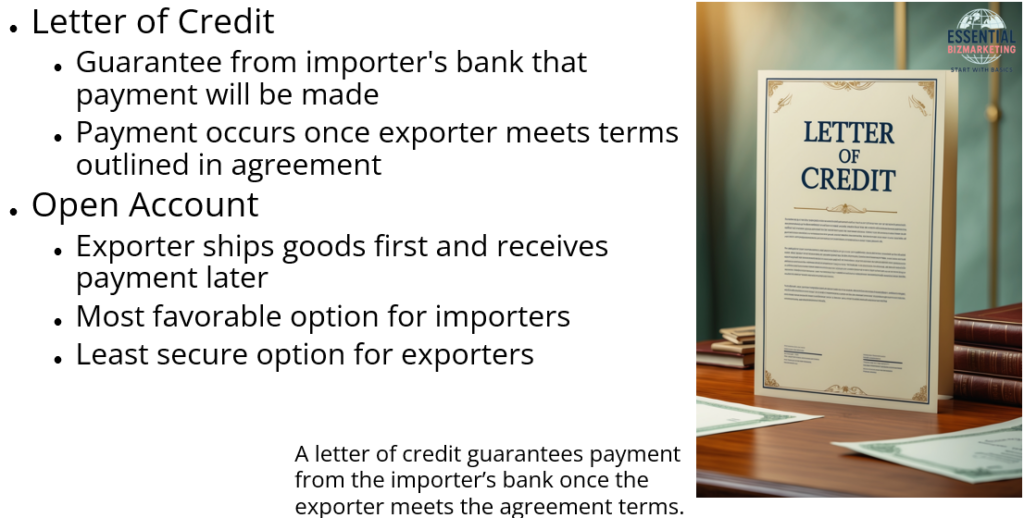
A letter of credit provides a guarantee from the importer’s bank that payment will be made once the exporter meets the terms outlined in the agreement. Open account transactions allow the exporter to ship goods first and receive payment later, making it the most favorable option for importers but the least secure for exporters.
4. Contractual Entry Modes
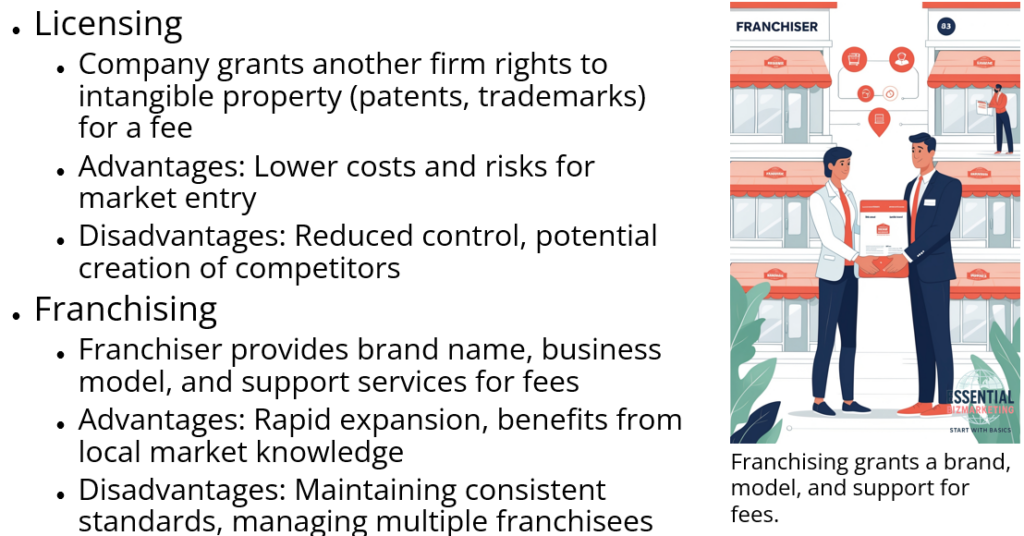
Companies that do not want to trade goods directly can expand internationally through contractual agreements. Licensing is a method where a company grants another firm the right to use its intangible property, such as patents or trademarks, for a fee. While licensing allows companies to enter foreign markets with lower costs and risks, it also reduces control and can create competitors. Franchising is another contractual method in which a franchiser provides a franchisee with a brand name, business model, and support services in exchange for fees. Although franchising allows for rapid expansion and benefits from local market knowledge, maintaining consistent standards and managing multiple franchisees can be challenging.
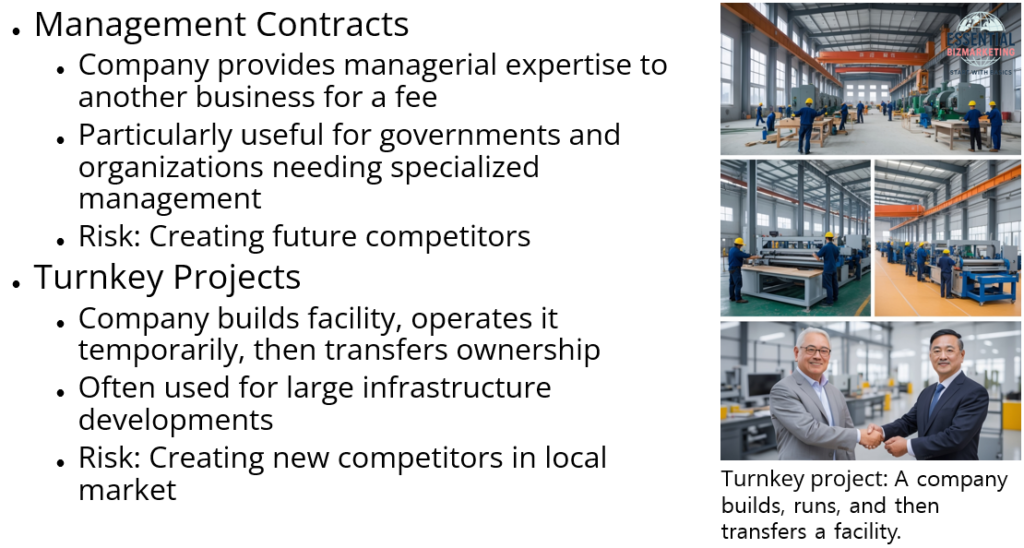
Management contracts involve a company providing managerial expertise to another business in exchange for a fee. This method is particularly useful for governments and organizations in need of specialized management but poses the risk of creating future competitors. Turnkey projects involve a company building a facility, operating it for a set period, and then transferring ownership to the client. These projects are often used for large infrastructure developments but can lead to the creation of new competitors in the local market.
5. Investment Entry Modes
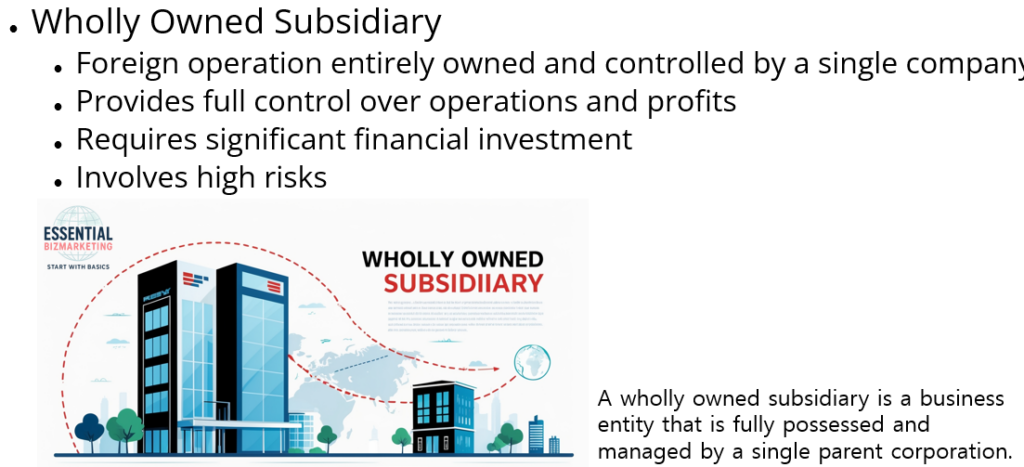
Companies that seek greater control and commitment in foreign markets often choose investment entry modes. A wholly owned subsidiary is a foreign operation entirely owned and controlled by a single company. This method provides full control over operations and profits but requires significant financial investment and involves high risks.
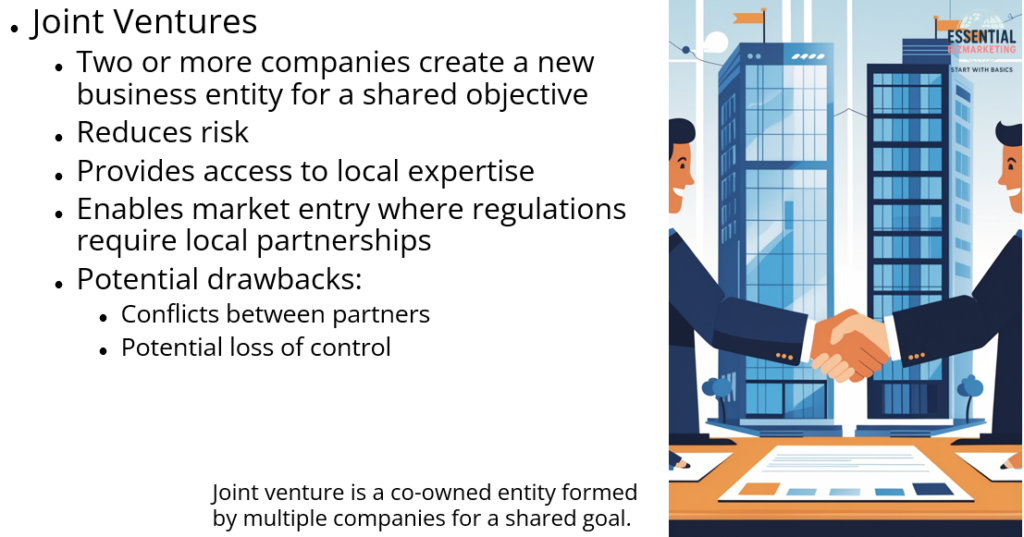
Joint ventures occur when two or more companies create a new business entity to achieve a shared objective. Joint ventures help reduce risk, allow for access to local expertise, and provide market entry where regulations require local partnerships. However, conflicts between partners and potential loss of control can arise.
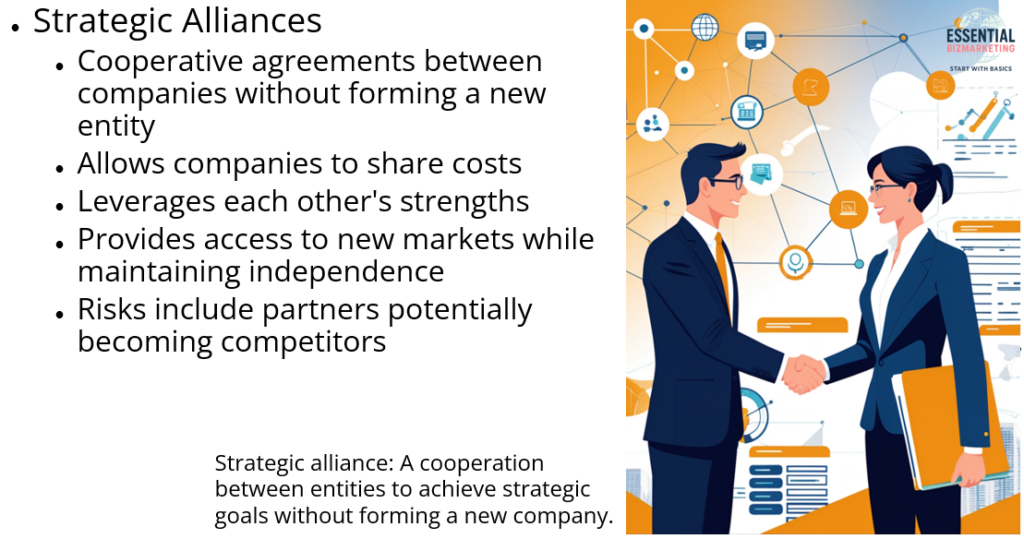
Strategic alliances are cooperative agreements between companies that do not involve forming a new business entity. These alliances allow companies to share costs, leverage each other’s strengths, and access new markets while maintaining independence. However, they also pose risks, such as the possibility of one partner becoming a competitor in the future.
6. Choosing the Right Entry Mode
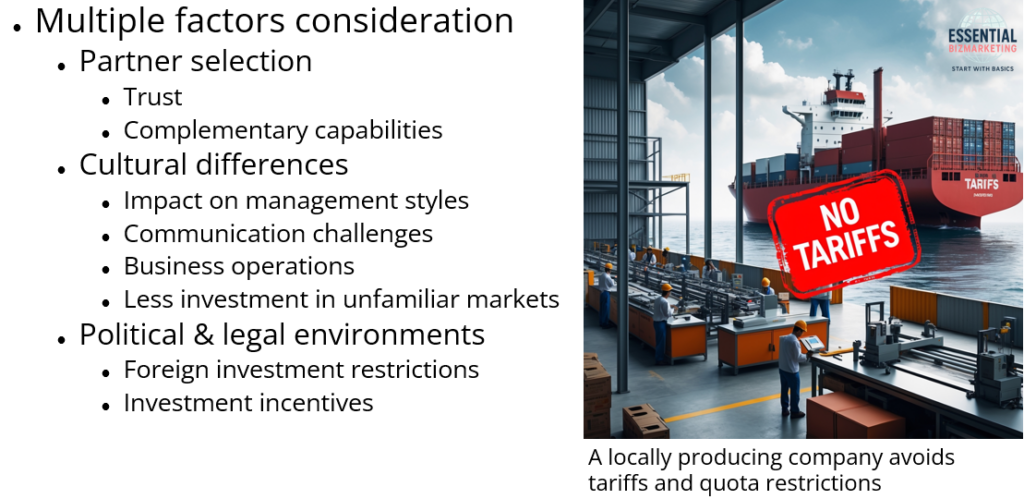
Selecting the most suitable entry mode requires careful consideration of multiple factors. Partner selection is critical, as successful cooperation depends on trust and complementary capabilities. Cultural differences can impact management styles, communication, and business operations, making investment entry modes less desirable in unfamiliar markets. Political and legal environments also play a significant role, as some countries impose restrictions on foreign investment while others offer incentives.
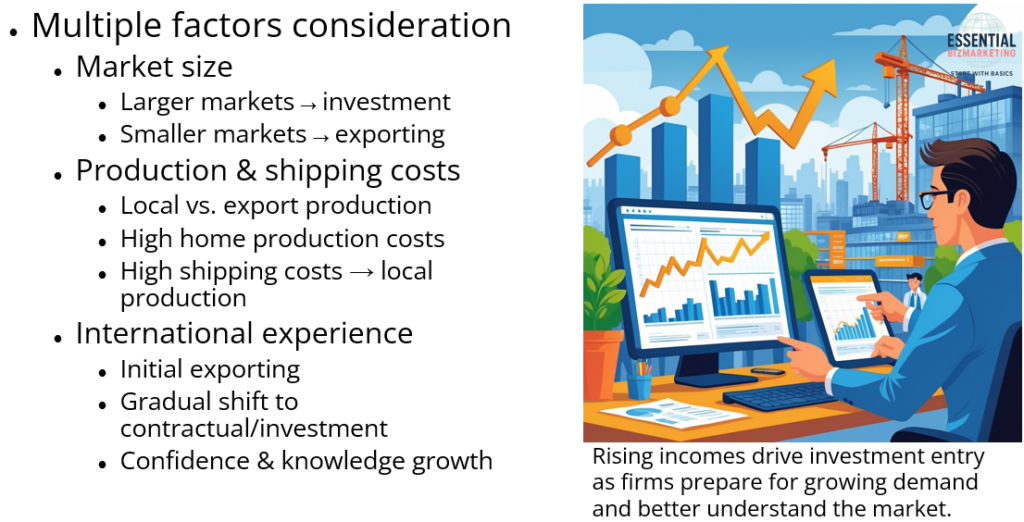
Market size is another important factor, as larger markets tend to favor investment, whereas smaller markets may be better served through exporting. Production and shipping costs influence whether a company should produce locally or export its goods. High production costs in the home country and high shipping costs may encourage local production. Finally, a company’s international experience shapes its entry strategy. Businesses often begin with exporting and gradually move toward contractual or investment entry as they gain confidence and knowledge about international markets.
7. Conclusion
Selecting an appropriate market entry strategy is crucial for international expansion. Companies must align their entry mode with their overall strategy, balancing risks, costs, and control. While exporting is often the first step for many businesses, contractual and investment entry modes offer greater market integration. Ultimately, the choice of entry mode should reflect the company’s capabilities, market conditions, and long-term objectives.
Related videos
- Title: Batesville Company Grows With the Help of Special Export Loan
- Title: Russia and Pakistan Barter Lentils for Rice Amid Payment Struggles – Firstpost Vantage with Palki Sharma
- Title: Shake Shack has big plans for Asia: CEO
- Title: Sony, Honda team up for EV venture
- Title: The Nissan–Renault Shakeup, Explained in Five Minutes
📚 References
Wild, J. J., & Wild, K. L. (2019). International business: The challenges of globalization (9th ed.). Pearson.
📁 Start exploring the Blog
📘 Or learn more About this site
🧵 Or follow along on X (Twitter)
🔎 Looking for sharp perspectives on global trade and markets?
I recommend @GONOGO_Korea as a resource I trust and regularly learn from.
